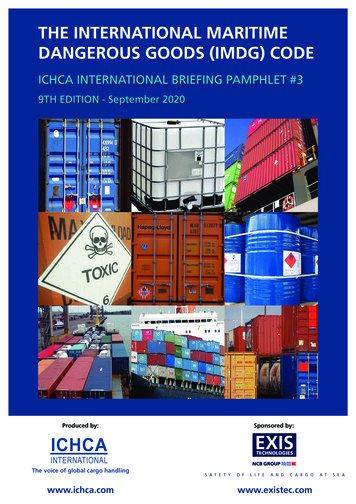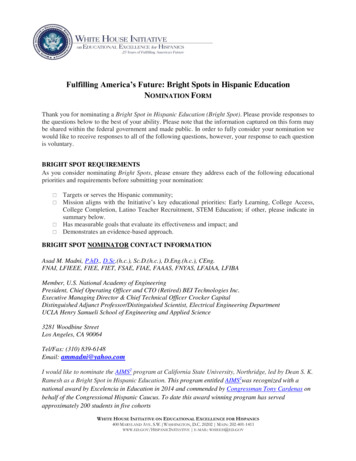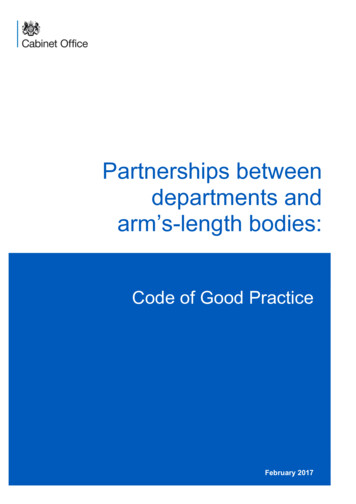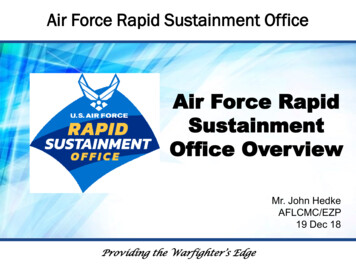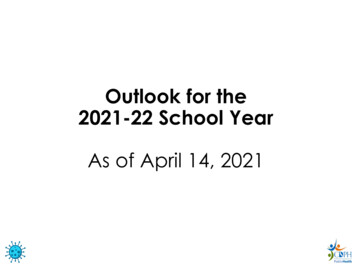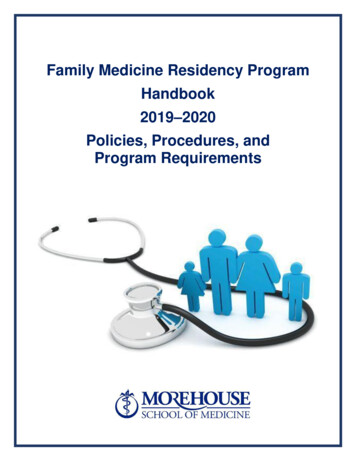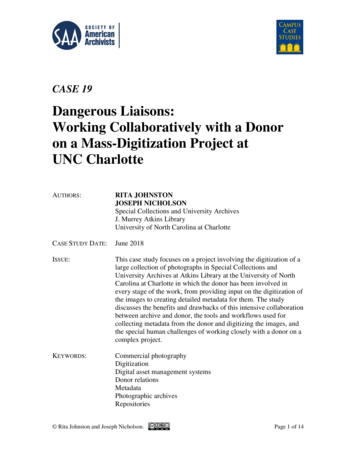
Transcription
CASE 19Dangerous Liaisons:Working Collaboratively with a Donoron a Mass-Digitization Project atUNC CharlotteAUTHORS:RITA JOHNSTONJOSEPH NICHOLSONSpecial Collections and University ArchivesJ. Murrey Atkins LibraryUniversity of North Carolina at CharlotteCASE STUDY DATE:June 2018ISSUE:This case study focuses on a project involving the digitization of alarge collection of photographs in Special Collections andUniversity Archives at Atkins Library at the University of NorthCarolina at Charlotte in which the donor has been involved inevery stage of the work, from providing input on the digitization ofthe images to creating detailed metadata for them. The studydiscusses the benefits and drawbacks of this intensive collaborationbetween archive and donor, the tools and workflows used forcollecting metadata from the donor and digitizing the images, andthe special human challenges of working closely with a donor on acomplex project.KEYWORDS:Commercial photographyDigitizationDigital asset management systemsDonor relationsMetadataPhotographic archivesRepositories Rita Johnston and Joseph Nicholson.Page 1 of 14
BackgroundEstablished in 1949 as Charlotte College, the University of North Carolina at Charlotte isone of the youngest institutions in the University of North Carolina’s sixteen-campussystem and—with 28,000 students in 2018—the fastest growing. The university’s ninecolleges offer twenty-three doctoral, sixty-four master’s, and 140 bachelor’s programs.The J. Murrey Atkins Library, a ten-story building at the center of campus, is a largeresearch institution with two million volumes and ninety-six faculty and staff.Until recently, Atkins Library’s special collections department devoted itself tohusbanding a modest collection of rare books and local history materials. In the past fewyears, the recently renamed unit, Special Collections and University Archives (hereafterreferred to as SCUA), has redirected its energies to strengthening its archival programsand launching mass-digitization initiatives. It has parlayed retirements into new archivistpositions, purchased new digitization equipment, and acquired an open-source repositorybuilt on the Islandora platform. Despite recent faculty hires, the unit lacks the layers ofspecialized staffing and the robust budgets of special collections departments at largerinstitutions, as well as their technical expertise.The most notable of SCUA’s recent projects is the digitization of the Bryant McMurraymotorsports photographs, a vast collection of more than 450,000 images of motorsportsevents and personalities donated by a noted local motorsports photographer. Capturingthe speed and danger of NASCAR races, celebrated drivers at play and in the heat ofaction, press conferences, parties, and motorsports fans, the collection charts the historyof the sport, which has close ties to the Charlotte region, from the late sixties to thepresent day. The collection contains black-and-white and color photographs taken withboth film and digital cameras in a variety of formats.The project was conceived on ambitious lines. Rather than pare the projected digitizedcollection down to a more manageable size, SCUA committed itself to begin digitizingall the donated images in more or less the order in which the donor had arranged them,without setting forth a plan for selection. And instead of opting for a collection-levelapproach to metadata, it proposed to describe all of the images at the item level, assigningaccess points with controlled vocabulary to every person identified and every race,racetrack, and track location depicted in the images. The intent was to create a vastsearchable database that would enable users to find images of drivers and othermotorsports personalities and events with pinpoint accuracy through faceting andhyperlinked controlled value terms.Working closely with the donor himself, Bryant McMurray, promised to be as unique achallenge as digitizing the images and creating metadata for the collection. Talkative andopinionated, a skilled raconteur, McMurray is deeply interested in every aspect of theproject that is centered on his life’s work, from the digitization process to copyrightstatements to the metadata. Though he had committed to deliver all of the photographs toSCUA, the donor planned to use the image collection as his working archive and as acommercial showcase for the images at the same time that SCUA was digitizing them.SAA Campus Case Studies – CASE 19Page 2 of 14
Most significant of all, the library had contracted with McMurray to provide metadata forthe images, principally in the form of identifications of people depicted therein butpossibly including other information as well, such as the make and model of racecars andcaptions for noteworthy images.The difficulties of the project seemed considerable as staff began work. Early on, staffconfronted the problem of determining what metadata elements the donor couldreasonably be expected to provide and with what tools. Training a donor unfamiliar withlibrary standards for description to create metadata was an obvious hurdle. There was thechallenge of devising an efficient method of creating a huge volume of item-levelmetadata for the images in MODS (a standard that SCUA had not used before), mixing inthe donor’s metadata, and ingesting the records into an unfamiliar repository. In addition,there were misunderstandings about the purpose and speed of the project that were almostcertain to arise between a commercial photographer principally interested in rough andready online access to his photographic archive and SCUA staff concerned with ensuringthat the project met rigorous archival standards and specifications.Case MethodologyCreator, Purpose, and Content of CollectionThe Bryant McMurray Photographs and Personal Papers collection primarily comprisesphotographic materials created from1969 to 2014 by Bryant McMurray, a 50-yearveteran of photojournalism, marketing, and public relations in motorsports. Afterconversations beginning in 2008 between McMurray and departmental leadership inSCUA, UNC Charlotte entered an agreement with McMurray to obtain the collection andbegan acquiring McMurray’s materials in 2014 in multiple accessions.During the initial talks with McMurray, he expressed a strong interest in having hisanalog photographic materials digitized, and assurances that the library would digitize alarge portion of his film collection led to his decision to enter a donor agreement withUNCC. McMurray hoped that this partnership would lead to the creation of a vastrepository of his digital content and had high expectations for the marketing andpromotion of this collection, which would in turn increase demand for licensing requestsfor his photography.SCUA leadership changed over the years leading up to the donor agreement, but theunit’s motivation for acquiring Bryant McMurray’s motorsports photography remainedthe same: the economic, cultural and historical ties the Charlotte region has tomotorsports. As of 2011, the motorsports industry brings about six billion to NorthCarolina’s economy annually and creates over 20,000 direct and indirect jobs.1 TheCharlotte region is the home of the Charlotte Motor Speedway, the NASCAR Hall ofFame, prominent NASCAR racing teams including Richard Petty Motorsports and1North Carolina (State), General Assembly, An Act to Adopt Stock Car Racing as the Official Sport of NorthCarolina, (SB 322) Sess. 2011, North Carolina General Assembly, accessed September 22, te/PDF/S322v3.pdf.SAA Campus Case Studies – CASE 19Page 3 of 14
Hendrick Motorsports, and multiple NASCAR offices—UNC Charlotte offers aMotorsports Engineering concentration through the William States Lee College ofEngineering. Charlotte also serves as a significant “memory community,” or space forfans to engage with a shared narrative of the history of racing.2McMurray emerged from talks with the library with a strong sense that SCUA would beable to digitize more of his collection and devote more resources to its promotion than itrealistically could with current resources. Though such commitments were not specifiedin the donor agreement itself, the library may have unwittingly played a part inencouraging high expectations in the donor that were almost certainly to be disappointedas the project moved forward and optimistic prognostications of swift progress collidedwith the unpleasant realities of recalcitrant equipment and budgeting and staffingconstraints. These expectations led to tensions in the donor-library relationship that havenever been fully resolved.The Nature of the RecordsThe bulk of materials in Bryant McMurray’s motorsports collection are 35mm negativescut in strips of six or fewer, but also include medium-format negatives, mounted colorslides, and about 200 GB of born-digital images on a hard drive. McMurray held on tomost of his material during the first several years of the project, transferring materials tothe library periodically in small accessions, but conveyed the remainder of hismotorsports negatives and a sampling of his slides to SCUA in November 2017. Hecontinues to commercially license his photographs, so was reluctant to part with his entirecollection before SCUA had established that it could provide access to a completeinventory of his work and fulfill requests on demand for images.McMurray organized his negatives through a homegrown paper-based indexing systembeginning early in his career, and SCUA deviated very little from the donor’sarrangement. He assigned sets of negatives taken during a motorsports racing event aunique number and kept the sleeves associated with the event in a labeled envelope. Hemaintained a typed alphabetical index of events and event numbers on notecards, andorganized film strips in envelopes with the event name, year, and number. McMurraycreated contact sheets from negatives for all of the events which he used to locate andselect images for a particular purpose.Custodianship/Restrictions on UseThe donor agreement signed by Bryant McMurray and UNC Charlotte stated thatMcMurray would retain copyright to all materials in his motorsports photographycollection until his death, upon which time full copyright would transfer to UNCCharlotte. It also stipulated that McMurray would transfer his materials in batches, and2Ronald L. Mitchelson and Derek Alderman, “Red Dust and Dynamometers: Charlotte as Memory and KnowledgeCommunity in NASCAR,” in Charlotte, NC: The Global Evolution of a New South City, ed. William Graves andHeather A. Smith (Athens: University of Georgia Press, 2010), 70, accessed June 19, 2018,https://muse.jhu.edu/book/14695.SAA Campus Case Studies – CASE 19Page 4 of 14
that UNC Charlotte would digitize part of his analog collection. To prevent unauthorizeduse of McMurray’s collection and preserve his ability to financially profit from his work,all content made digitally available would need to have reasonable protections in place toblock downloads.The agreement additionally specified that for the first two years of the project the librarywould pay McMurray to supply metadata for his images, placing the library in theethically awkward position of remunerating him for work that would increase theexposure and hence marketability of his own collection. The agreement did not indicatethe type or extent of metadata he would provide or the tools he would use. Filling in theselacunae and ensuring that the project had a sound academic basis no matter what materialbenefits it might provide to the donor were to become some of the most challengingaspects of the project as it moved into its production phase.Long-Term Preservation of Digital Objects and AccessSCUA had been publishing digital collections in CONTENTdm since the 2000s, but thedepartment did not have an integrated preservation and access system. Also, theCONTENTdm repository was not a viable option for publishing certain types of content,including SCUA’s oral history interviews and electronic theses and dissertations.After exploring options, Atkins Library decided to build a new digital asset managementsystem utilizing the Islandora open source framework, which offers a balance betweenout-of-the-box and boutique digital asset management systems. The new repository wasintended to be a home for content including digitized and born-digital materials held bySCUA, born-digital local government documents, and electronic theses and dissertations.At the same time, Atkins Library and campus ITS were moving away from permanentlystoring digital objects on local servers. The new repository would be integrated withAmazon Web Services (AWS), so that upon ingest, digital objects would be copied toAWS Glacier for long-term storage.Atkins Library’s Technology and Digital Strategies team installed and configured thelibrary’s Islandora repository, branded Goldmine, by late 2014. While they continue towork on optimizing and improving all aspects of Goldmine, the new repository wasoperational by the start of the McMurray motorsports digitization project.Pilot ProjectAs promises to swiftly and exhaustively digitize Bryant McMurray’s photographicmotorsports collection were a motivating factor in his donation of the collection to AtkinsLibrary, SCUA embarked on a pilot digitization project from August 2014 to September2015. The unit acquired a representative sample of materials from McMurray, primarily35mm negative strips but also some medium format negatives and 35mm mounted slides.From the digitization pilot study, the Digital Production Librarian and the Processing andTechnical Assistant learned that existing equipment in the department was inadequate forSAA Campus Case Studies – CASE 19Page 5 of 14
digitizing McMurray’s collection of motorsports photography. Pilot project staff used aflatbed scanner with plastic transparency holders, but the holders couldn’t flatten out thefilm enough to get a clear scan of the images. Additionally, using a flatbed to scan at thehighest resolution and the post-scanning workflow was incredibly time-consuming.Because of these issues, SCUA was able to successfully make the case for purchasing aHasselblad Flextight X5 scanner, which was acquired by the department in summer 2015.One of the primary objectives of the pilot project was to test out methods of collectingmetadata from the donor. McMurray’s previous experience with spreadsheets andSCUA’s heavy reliance on that tool in previous digital projects suggested that Excel wasthe most appropriate medium for gathering his data. The initial plan was to send himmetadata spreadsheets for the images in each sub-collection within the larger collectionof photographs via a Dropbox account. Working from small images loaded directly intothe left-most column of the spreadsheets, the donor would enter identification of people,makes and models of cars, and free text comments in columns reserved for his data.Dropdown menus preloaded with driver names would assist him in his annotations.Unfortunately, the donor found it difficult to read the small script in the dropdowns andclick the name terms into place, and he was unable to identify the makes and models ofcars in the small images. Moreover, the cramped Excel format discouraged him fromcreating the detailed captions for which project staff were hoping.The pilot project made it clear that metadata staff had inflated expectations about theextent of the metadata the donor could supply and the tools they had devised to collect it.Scaling them back, they decided to ask the donor only for identification of persons andoccasional free-text notes that metadata staff would then expand into full captions. Theyalso began to think about the possibility of finding tools other than Excel to gather hisdata. Yet it would be more than a year before a suitable method was developed.Current Metadata Creation ProcessThe photograph collection is arranged in smaller sub-collections that document particularracing events, such as the 1977 Daytona 500 or the 1975 National 500. Each subcollection contains somewhere between 50 and 300 images on average. For each racingsub-collection, project staff create an Excel metadata spreadsheet containing columnsrepresenting some 20 elements that correspond to MODS elements such as title, extent,subject, abstract, etc. They rely heavily on the MODS User Guidelines for version 3developed by the Digital Library Federation and the Library of Congress but use MODSversion 3.6 in metadata records created for the project.3 An Excel extension program,Kutools, is used to load JPEGs of the digitized images into the far left column of eachspreadsheet. The images serve as useful reference points as staff assign subject andnames terms.Staff use several approaches to accelerate metadata creation. In lieu of devising anindividual title for each image, they use a formulaic title based on the name of the race3“MODS Version 3 User Guidelines,” Library of Congress, last updated January 8, 2018, accessed June 19, SAA Campus Case Studies – CASE 19Page 6 of 14
(e.g. “1972 Coca-Cola 600 events”) to which is appended the incrementing phrase“image 1,” “image 2,” “image 3,” etc. for the remainder of the photographs in the subcollection spreadsheet. Instead of Library of Congress Subject Headings, project staffprefer topical terms from the FAST (Faceted Application of Subject Terminology)vocabulary developed by OCLC, which student workers can apply more swiftly. Thesetopical terms, along with controlled vocabulary for personal name subjects derived fromLibrary of Congress authorities and local authority files, are placed in columns of thesecond tab of the spreadsheet and clicked into place in the appropriate columns in tab oneusing the Excel data validation functionality. Some tweaks to the Excel coding enablestaff to insert more than one FAST topical and name term per cell.Figure 1. Controlled vocabulary terms and uniform resource identifiers (when available) are inserted into Excelmetadata spreadsheets with dropdown menus.Once the metadata has been created and proofread, the spreadsheet is saved as a text fileand then uploaded to OpenRefine. Prior to this stage, a template record is created inMODS in Notepad that contains every element and attribute used in the project. Afterapplying the template record to the metadata in OpenRefine, staff export a collectionlevel record containing individual XML MODS records for every row in the spreadsheet.At this stage, two simple XSLTs strip out detritus from the resulting file, split the largecollection-level file into individual MODS files for each image, and rename the resultingfiles after the filenames of the images. The image files and metadata files are then unitedin an ingest directory on the NAS. UNC Charlotte developers have created a backendpipeline from the NAS to Islandora that allows project staff to ingest collections into therepository in a fraction of the time that ingest through the web interface would require.Current Donor Metadata ProcessOnce project staff have uploaded the images and metadata files to the repository, theynotify the donor that a new sub-collection is ready for his annotations. The donor thenlogs into the Islandora repository and completes his metadata for the sub-collection usingan annotation tool that digital initiatives staff at Atkins developed for his use in 2016. Thesub-collection remains under embargo until staff proofread the donor’s metadata.SAA Campus Case Studies – CASE 19Page 7 of 14
Figure 2. Annotation tool developed for the donor in the Islandora repository. The donor enters identifications ofpersons in the images and other relevant information in the panel on the right.Based on Drupal form technology, the tool enables the donor to fill out a simple form foreach photograph in a specified collection. The form includes boxes for names of peopleand a larger text box for free-text notes. The zoom capabilities of the Islandora imageviewer allow him to see the images with a clarity and detail that were impossible in Excelthumbnails, encouraging more detailed and accurate metadata.When the donor completes each form, he clicks on a “submit” button and toggles to thenext image in the collection. After he finishes his annotations, project staff ingest theminto an XML metadata form they have created in Drupal and edit them to conform toproject standards. Name forms entered by the donor are converted into authorized projectforms. Free-text notes are edited into complete sentences or deleted as appropriate. Whenproject staff finish editing and proofreading the donor’s metadata for a particularcollection, the embargo is lifted and the sub-collection is made public.SAA Campus Case Studies – CASE 19Page 8 of 14
Figure 3. Donor’s free-text annotations from the annotation tool are dumped into an XML form thatproject staff built in the Islandora repository. Staff then use a taxonomy function to normalize thename forms the donor enters.Access MechanismsThe digital Bryant McMurray motorsports collection is available through Goldmine, thepublic view of the Islandora repository. The Digital Public Library of America harveststhe collection several times a year through the North Carolina Digital Heritage Center,the North Carolina service hub, and makes it available through its interface. Otherpotential access mechanisms include the library’s Ex Libris Primo discovery system,which could host MARC records derived from the Islandora MODS records or DublinCore records harvested from the repository using OAI.Partners in Forming a Digital SolutionThough SCUA staff have performed all imaging and metadata work for the project thusfar, developers in the library’s Technology and Digital Strategies unit have been cruciallyimportant to the project’s success. They built the Islandora repository from the ground upand assisted project staff with their first experimental ingests of motorsports images andmetadata. Chief among their contributions are the NAS ingest tool for quickly loadingcollections into the repository and the annotation tool for the donor.Resources RequiredAware from the beginning that staffing and budget constraints would sharply limit thenumber of project participants, project staff attempted to design workflows that wouldenable a small number of staff to produce a large volume of images and metadata. Theywere also conscious that in the absence of numerous full-time staff in the department,student workers would need to perform highly specialized work ordinarily assigned toFTE. Carefully vetting student hires and extensively documenting workflows has allowedthe department to make the most of a depleted workforce.SAA Campus Case Studies – CASE 19Page 9 of 14
Staff involved in building the motorsports digital collection include one digitalproduction librarian, a staff member responsible for managing day-to-day imagingworkflows, and a metadata librarian. Seven to eight undergraduate student assistantsperform tasks ranging from digitizing analog photographs and slides to performingquality control on images to creating and transforming metadata. During the summer of2017, the department hired a full-time intern to extract born-digital images from thephotographer’s hard drive, process the images, and devise born-digital metadataworkflows based on already-established processes for the description of digitized images.Previously, project staff had concentrated exclusively on providing access to digitizedphotographic materials.AnalysisGeneral ReflectionsSome of the difficulties that arose during the project can be traced to the heightenedexpectations that the library may have unintentionally encouraged in the donor early inthe project. In the heady early days when a project is first taking shape, it is easy for staffand donors to allow rosy visions of phenomenal progress to obscure the gritty realities ofbudget and staffing shortfalls that are sure to complicate any undertaking as large as theMcMurray motorsports project. In retrospect, it would probably have been prudent forproject staff to confine their commitments to the donor in the beginning stages of theproject to what they knew they could actually deliver. Doing so would almost certainlyhave eased frictions that developed during the project and made for a more harmoniousdonor-library relationship.DigitizationLearning to work with the Hasselblad Flextight X5, training students on digitalproduction processes, and ensuring quality of digital images remained challengesthroughout the project. The donor had high expectations for speed, volume, and thecreation of images with a finished look which Atkins, relying on a largely studentworkforce, couldn’t always meet.When UNC Charlotte purchased the Flextight scanner and batch tray feeder, the digitalproduction librarian had hoped that staff would be able to load multiple trays of 35mmnegative strips and walk away while the machine scanned. Project staff learned thatmonitoring and occasional human intervention was needed during the scanning process toprevent various issues that would affect the quality of images. Also, more rescanning ofimages than we had anticipated was needed due to film shifting in the holders; holdersfailing to grip the film tightly during the entire scan, which resulted in blurry images; ortoo much dust, despite efforts to brush off debris prior to scanning.SAA Campus Case Studies – CASE 19Page 10 of 14
Figure 4. Student employee working with the Hasselblad Flextight.Negative digitization projects are further complicated by the necessity of additional stepspost-scan to produce an image that reasonably represents a print from the original object.Digitization staff are very conservative with image adjustments and avoid clipping detailin the light and dark regions. This would allow someone to use a copy of the preservationmaster digital file to emphasize various parts of the image, but depending on thephotograph, may result in a flat, uninteresting digital image. Additionally, color negativesin the collection, particularly the medium-format negatives, are degrading unevenlyacross the surface of the film. While we want to digitize and preserve a copy of thesematerials as they are now before they break down further, it’s not possible to createdigital images from the color negatives that would look the same as a print created fromthe film around the time of capture in the 1970s.Figure 5. “Bubbling” issue with Flextight flexible holders for 35mm strips.SAA Campus Case Studies – CASE 19Page 11 of 14
MetadataFigure 6: Sample metadata record for motorsports image in Goldmine repository.Staff made a number of errors during the project. Many had less to do with project designthan with a lack of sensitivity to the donor’s needs. A defensiveness about archival andmetadata standards and an inflexible adherence to established workflows may have ledproject staff to view his difficulties with Excel as a peripheral problem, for instance. Theywere almost certainly too slow in devising a more simple and convenient tool forrecording his metadata.Reducing the difficulty of metadata creation, the new metadata annotation tool hasaccelerated the pace of the donor’s work and eased some of his concerns about theproject’s slow rate of progress. It has not, however, cleared away the problems withcommunication that would be likely to arise in any project involving multiple participantscreating complex metadata. In some cases, staff must contact the donor by email to getclarification about ambiguous metadata. Staff also contact the donor each time a newcollection is ready to annotate. Sometimes the donor believes that he has been sent workhe has already performed, an experience that increases his frustration with how rapidlythe project is progressing. Though more than 8,000 images have been ingested since theSAA Campus Case Studies – CASE 19Page 12 of 14
project began, the donor believes that SCUA should be digitizing and creating metadatafor his photographs at a far faster rate. The rapidity with which he is able to complete hispart of the metadata with the new metadata tool has increased his sense that SCUA’s ownpace is laggardly.Finally, the extremely granular, item-level metadata that the project designers committedthemselves to record for each photograph has resulted inevitably in a slow rate ofproduction for the project. It is not difficult to imagine approaches to creating metadatathat would have been swifter and still made use of donor metadata: collection-leveldescriptions for each sub-collection that included general information about personsappearing in the images, for instance, but no metadata at the item level. Adopting these orsimilar measures might have increased output and assuaged some of the donor’s concernsabout the project’s speed.Project ResultsDespite occasional misunderstandings, SCUA and the donor have together created animmense, still-growing digital photographs collection with rich, intensely detailedmetadata about motorsports culture and personalities that project staff could never haveprovided on their own. The project has succeeded in capturing much of the donor’sencyclopedic knowledge of motorsports and passing it on to users in the form of free-textnotes and controlled vocabulary that allow them to search his vast photographic archiveswith great precision and speed. Though mediated by staff members, the metadata he hascontributed allows him to speak to users about his life’s work with a clarity and detailthat is denied to most donors of archival collections, who must rely on archivalintercessors to interpret their collections for the public.Project staff have derived a number of benefits from the project, not least the confidencethat comes from launching a large project with extremely limited means. They haveapplied many o
events and personalities donated by a noted local motorsports photographer. Capturing the speed and danger of NASCAR races, celebrated drivers at play and in the heat of action, press conferences, parties, and motorsports fans, the collection charts the history of the sport, which has close ties to the Charlotte region, from the late sixties to the

